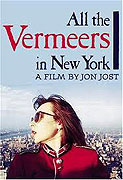
Directed by:
Jon JostScreenplay:
Jon JostCinematography:
Jon JostComposer:
Jon A. EnglishPlots(1)
Yuppy Mark works at the New York stock exchange, a career that's making him rich but not happy. The Metropolitan Museum is his place of refuge; as often as he can, he goes there to look at the paintings by Vermeer. One day, he sees a woman in one of the galleries who looks like the women in Vermeer's work. Intrigued, he follows her. She turns out to be a French actress who is having difficulty making ends meet. Hesitantly, she agrees to meet him, and later on in their relationship, she still sees him principally as a source of income. Until it comes to an abrupt end. All the Vermeers in New York is the story of an impossible love between two people from different milieus in a city which we see almost entirely through interiors, but which is nevertheless a prominent presence. Art seems to be the only pure point of reference in the midst of the capitalist rat race. (International Film Festival Rotterdam)
(more)Reviews (1)
Formally, even with Jost's victorious reiteration of Euro-Atlantic liberalism at the turn of the 80s and 90s, there was a prevailing backward movement towards an even more classical narration than what we knew from films of previous decades: the experimental intellectual guerrilla warfare of American social relations with post-structuralist leftist discursive and socio-political critics gradually disappears and what remains is the best of the long-gone promise of reasonable, moderate, intelligent democratic liberalism that was also dreamed of in Czech fields and woods after the end of state socialist dictatorship, and that, as we later discovered, never existed. While watching the film, not only because of the shots of Vermeer and at one moment also of Rembrandt, I remembered Joseph Heller and his "Picture This" from 1988, in which Rembrandt looks down at humanity and its history from the walls of the Metropolitan Museum in New York. The film gives off the same feeling as that old good Jewish liberal Heller in all its grandeur: the sensitive irony towards the vanities of everyday life's afflictions and the focus on what is important, even though what is important may not even exist, and even if it did exist, we may never achieve it. And yet, there is no choice but to try. This sentiment is felt much more in this film than in Jost's Rembrandt Laughing from 1988 (Yes! That cannot be a coincidence.). For Jost, just like with Godard, his former inspiration, from whom, however, his work will fundamentally diverge from this moment on, there seems to have been, briefly, a predominance of the desire for something enduring after the disappointment of iconoclasm, something that hides behind the disillusionment of the world and the disillusionment of its effective criticism and transformation, which both authors hoped for but did not come true... Just like in Godard's The Detective (1985), perhaps the only way out of the confusion of life appears to be love, which is eternal.
()